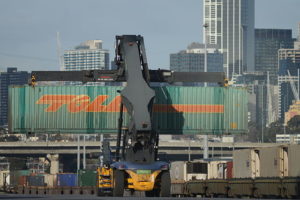
Recording growth of 8.0% last year, the market expanded at its quickest annual pace since 2010. This was driven by strong growth in both air and sea freight which both saw year-on-year increases, while forecasts reveal that sea freight is positioned to continue healthy growth over the short to medium term, said the report entitled “Global Freight Forwarding 2018.”
It also noted the changing role of freight forwarders as they, especially the largest players, embrace technology to transform their operations from within.
The entry of “tech forwarders”—including digital forwarders and spot market platforms—has driven the largest forwarders to enhance their own technology usage and the capabilities they offer to shippers, said the paper.
“Perhaps more than ever, freight forwarding stands at a crossroads with forwarders large and small facing significant challenges and threats in a market characterized by strong growth and abundant opportunity,” said Ti.
“Customer-centricity is at the top of the agenda as the world’s largest freight forwarders look to drive efficiency and establish new routes to market,” the report said.
Meeting the challenges and overcoming the threats requires forwarders embrace technology, drive scale and efficiency in their operations, and truly put shippers at the center of their operations, it added. These same drivers are also the clearest route forwarders have to capitalizing on the opportunities in today’s market.
“At its core, forwarding remains a process of buying space and securing volumes, of ensuring goods reach destination on time and in good condition, and of building trust and lasting customer relationships. In 2018, we see and hear so much about logistics service providers moving to embrace advanced technologies like artificial intelligence and blockchain, it’s easy to miss that many of the world’s largest forwarders are renewing their focus on core activities and achieving higher service levels,” said Nick Bailey, head of research at Ti.
”After being caught unaware by the entry of a new breed of tech-enabled forwarders into the market, the traditional players have come to see technology as a force magnifier in value creation, but not as the center of their offer,” he added.
Alongside market sizing, the report also takes an in-depth analysis of the opportunities small and medium enterprises (SMEs) offer forwarders. It has long been an ambition of many of the world’s largest air and ocean forwarders to win additional business from SMEs. And with the widespread rollout of online freight quotation and booking platforms, there has been a renewed forwarder focus on SMEs.
“At present, SME business for forwarders is typically higher margin than that of large shippers. Interviews with senior forwarding sector stakeholders revealed that the enhanced price transparency of SME-targeting online rate quotation and booking platforms is having a negative effect on gross profit margins. However, lower process costs associated with a slicker front-end and greater automation of back-end processes mean there are cost savings to be realized. The extent to which these are achieved will be a key battleground for forwarders targeting SME business,” said David Buckby, economist at Ti.
Photo: Brycewhite









